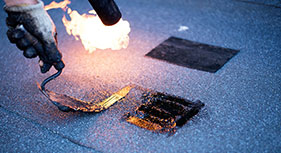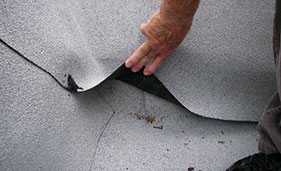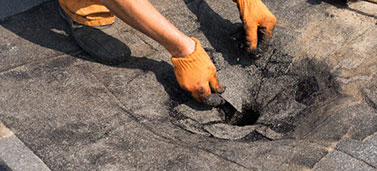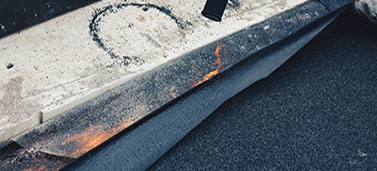Maintenance of Bituminous Membrane
Modified materials have inherent characteristics that require proper maintenance over their service life. Dark surfaced membranes, such as modified bitumen roofing substrates, absorb a majority of the sun’s UV rays generating excessive heat on the roofs surface. This heat gain can cause several damaging effects to your modified bitumen roofing membrane, including: premature aging, splitting and cracking, blistering, and overall brittleness of the membrane. These symptoms are the primary cause your roof begins to leak.
There are two primary types of modified bitumen systems: atactic polypropylene (APP) and styrene-butadiene-styrene (SBS).
APP

APP is not compatible with asphalt and can only be torch applied. APP can be torch applied because the modifiers extend the asphalt without changing its basic characteristics. This allows for a thicker asphalt content to be applied to the base of the membrane sheet. The additional asphalt content of the sheet-when torched-provides the adhesive capacity of the membrane to the substrate. The polypropylene content should be in a 25 percent ratio with the asphalt to achieve the proper characteristics.
Long-term performance capabilities have been affected by asphalt polymer separation, which has in some cases led to premature failures. When the APP network progresses toward its natural aging limit, the APP becomes separate and distinct from its asphalt counterpart. This separation accelerates the rate of degradation leading to a quick transition from adequate performance to failure. This dynamic would indicate that APP membranes require protective surface coating during initial application for long-term ultraviolet protection.
Another concern with these applications is membrane seam failures. These types of problems, which can be identified by open and unadhered seams, are often the direct result of improper torch application. Proper repairs require torch or heat welding of the seams.
SBS

SBS asphalt uses 10-15 percent of a rubber polymer called styrene-butadiene-styrene as an additive to the asphalt modifier. This form of modified asphalt has many of the characteristics of rubber, including its excellent elongation capacities. The surfacing of the sheets is also a maintenance concern. Although SBS sheets are not as sensitive to ultraviolet light as APP sheets, there is still a possibility of degradation. Typical surface degradation can be identified by membrane grazing, cracks, and in extreme cases, alligatoring.
Membrane degradation can also be the result of exposure to chemicals and oils. Membrane degradation can be identified by discoloration of the sheets, surface cracks and delamination of the sheets in localized areas. The membrane manufacturer should be consulted for proper repair procedures. It would be helpful to provide the manufacturer's technical staff with the type of chemical or oil that the membrane is exposed to so that they can provide the proper treatment methods.
Seam failures are also a concern with SBS applications. Seam failures can result from improper bitumen application or inadequate adhesive coverage. The repairs of these sheets can be achieved with bitumen application, cold adhesive or torch application. Most membrane manufacturers recommend the use of torch or heat welding at seams no matter what adhesion method is employed to install the membrane sheets.
Typical Repair Methods
Repair methods for SBS and APP membranes are generally the same. The only difference is the type of patch adhesion that is employed. The first step is to determine if water infiltration has occurred at the membrane opening. If moisture is present, open the membrane and inspect the insulation and deck for damage. Remove the wet or damaged insulation and repair or replace the deck as required. Properly attach new, dry insulation consistent with the thickness of the existing insulation and compatible with the other roof system components.
Remove all debris, contaminants, surfacing, ballast or loose granules from the surface of the membrane or flashing to be repaired. The prepared area should extend beyond the perimeter of the patch to provide an ample clean space on which to install the patch. Clean the surface of the membrane. If the membrane surface has been flood coated and aggregate embedded, carefully spud the aggregate free from the surface and sweep clean. The exposed asphalt flood coat may need to be heated with a torch in order to smooth out irregularities, then allowed to cool.
If the surface of the membrane is severely weathered, lightly prime the surface of the membrane with asphalt primer and allow it to dry. Primer contains solvents and is used to enhance adhesion; however, overuse of primer can harm the membrane. Cut a patch of like material 8 inches larger in all dimensions than the defect to be repaired. Round the corners of the patch to a minimum radius of 3 inches.
For SBS membrane sheets:

Install the patch in hot asphalt, cold adhesive or by heat welding in
accordance with the manufacturer's recommendation over the repair area,
extending 8 inches in all
directions from any part of the defect. When using hot asphalt as the method
of application, take care to maintain the asphalt at a minimum of 400° F at
the point of application. When torching, work gradually, applying heat only
sufficient to achieve adhesion without damaging the membrane reinforcement
or scorching the surrounding membrane.
For APP membrane sheets:

Install the patch in cold adhesive or by heat welding in accordance with the
patch manufacturer's recommendations over the repair area, extending 8
inches in all directions
from any part of the defect. When heat welding, work gradually, applying
heat sufficient to achieve adhesion without damaging the membrane
reinforcement or scorching surrounding membrane.
Modified bitumen sheets should not be installed in ambient temperatures of
40 degrees F or below.

